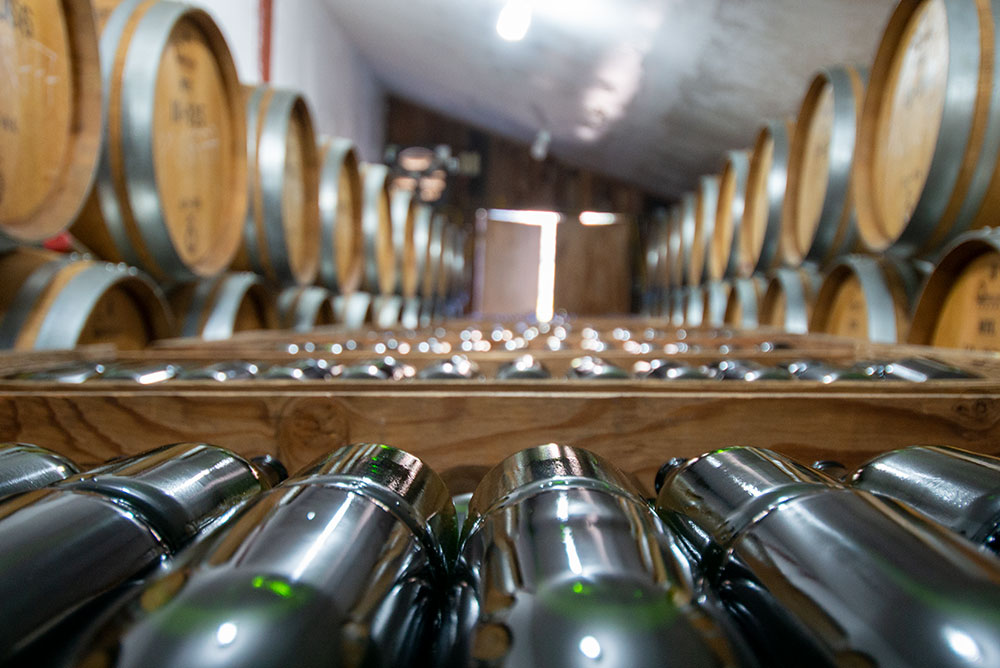Sparkling Wine for Perfect For Celebrations: The Back Story
While they’ve long played a role in modern celebrations, sparkling wines also have a rich and regal history. Produced throughout central and eastern Europe since the early 19th century, sparkling wine first rose to prominence among French and English nobility, with aristocrats favoring the bubbly blends during coronations and other special occasions.
By the 1860s, sparkling wines made their way to the West Coast of the United States and have undergone production in the region ever since (aside from the Prohibition era!).
In this image sparkling wine rests en tirage (aging on the yeast) prior to riddling at Navarro Vineyards.
Anderson Valley as a Premier Sparkling Wine Region
What is it about Anderson Valley that makes it such a solid place to produce sparkling wine? The climate is a major contributing factor. Grapes used in sparkling wines must undergo harvesting at a lower Brix (°Bx), which refers to the measurement of the sugar level in the grape. Anderson Valley maintains a cool, coastally influenced climate that helps grapes grown there maintain their acidity, making it ideal for producing sparkling chardonnay or Pinot Noir, in particular.
For evidence of Anderson Valley’s prowess as a sparkling wine-growing region, look no further than Scharffenberger Cellars’ 1981 Brut Excellence made from grapes from the Valley Foothills Vineyard, or Handley Cellars’ 1983 Brut Sparkling made from Pinot Noir and Chardonnay, the winery’s inaugural release. Other regional and historic highlights include Navarro Vineyards’ highly sought-after 1984 Sparkling Brut and Roederer Estate’s 1988 Roederer Estate Brut, which was the first domestic sparkling wine produced by Louis Roederer, who is often credited with revolutionizing the sparkling wine industry in California.
You can immerse yourself in these French and California sparklers at the Annual Pinot Noir Festival VIP Bubble Lounge the third weekend in May, hosted by the Roederer Family of Wines.
Click here to learn more – tickets are extremely limited!
Producing Champagne-Style Sparkling Wine vs. Still Wine
So, beyond the bubbles, what is it about sparkling wine that makes it so distinct from traditional, still wine? It starts with their production styles. The Methode Champenois, or the traditional production method for champagne-style wines, has the wine go through a second fermentation process once it’s already in the bottle. This produces carbon dioxide, which in turn creates the bubbles.
Still wine, on the other hand, typically does not contain the carbon dioxide element that creates the fizz and bubbles. To produce still wine, grapes, after picking, go through a machine that takes out their stems, seeds and skin.
Then, the fermentation process begins, which turns yeast into alcohol. After fermentation, the wine goes into barrels or tanks until it ages enough for bottling. In simpler terms, the main difference between the two production types is that still wine goes through a single fermentation process while sparkling wine goes through two.
In this image base wine is being added into bottle for the bottle fermentation process.
A Sparkling Wine Epicenter, Perfect for Celebrations
Once more of an under-the-radar sparkling wine region, Anderson Valley has since become something of a mecca for fans of this fizzy, celebratory drink. These days, 16+ Anderson Valley wine producers either offer sparkling wine varieties or have them in the works.
Planning a day or a weekend in Anderson Valley and have a hankering for sparkling wine? Click here for more about where to find the region’s best bubbles. Cheers!
In this image reserve wine is being aged in barrel at Roederer Estate prior to the cuvèe blending. Photo courtesy of John Williamson.
Sign Up for Our Newsletter
Get Updates On The Happenings In Anderson Valley!




